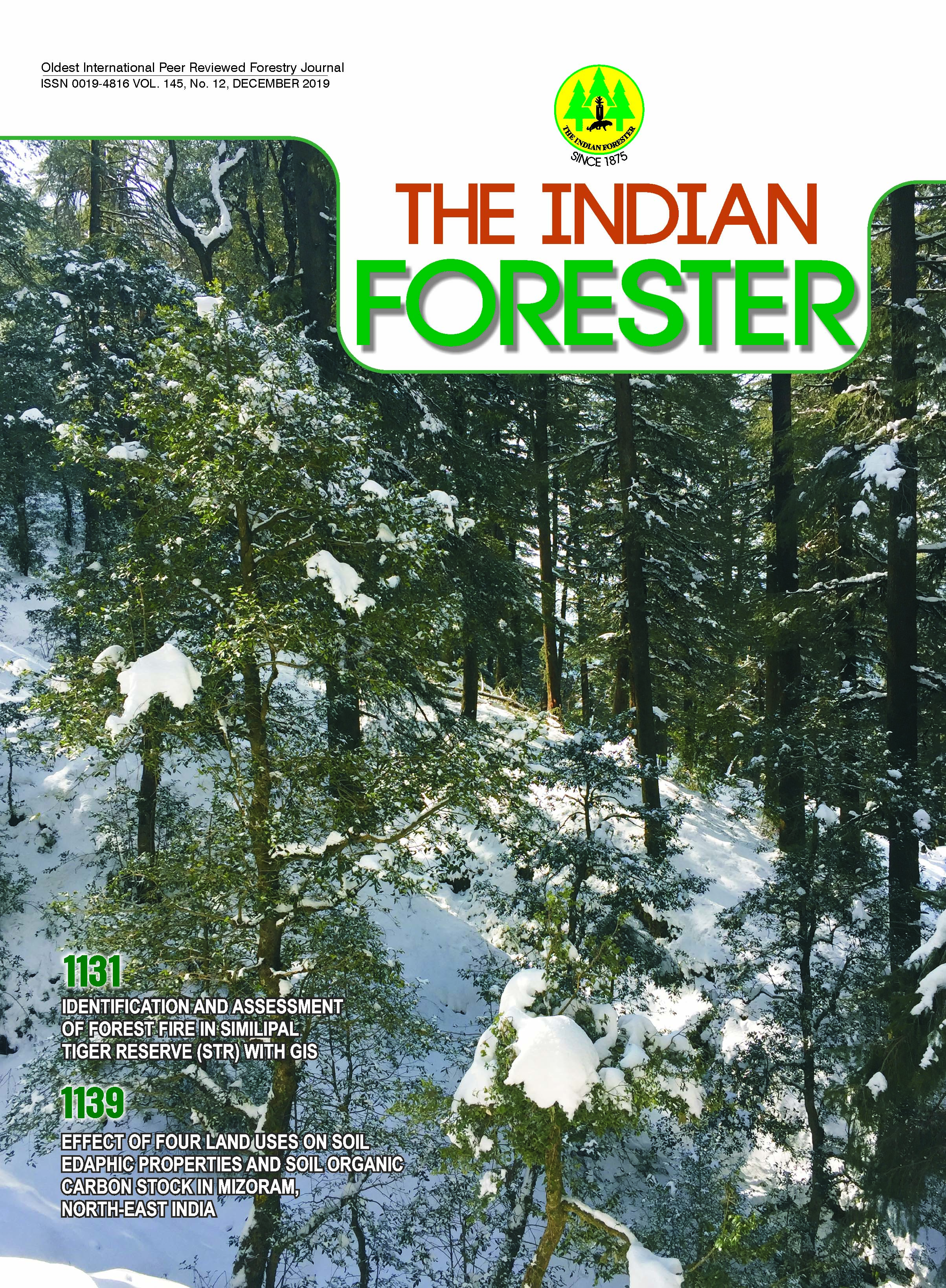Developmental Activities in Relation to Change in the Diversity-Distribution of Medicinally Important Plants in Vicinity of Serlui-B Hydel Project, Mizoram, India
DOI:
https://doi.org/10.36808/if/2019/v145i12/150640Keywords:
Developmental Activities, Diversity-Distribution, Medicinal Plants, Serlui-B Dam.Abstract
Dams are beneficial to the society in many ways, but developmental activities on construction site have detrimental effects on plant wealth and certain medicinal species are eliminated before fully assessed and validated. The findings of the present investigation on diversity-distribution of medicinal plants under undisturbed and disturbed forest stands in the vicinity of Serlui-B Hydel Project in Mizoram reveal that there is a drastic change in the plant community structure and botanical composition. Altogether, 140 species (118 species from 104 genera and 56 families in the undisturbed stand and 71 species from 63 genera and 31 families in the disturbed stand) belonging to 120 genera and 59 families were recorded from both the stands. The species sensitive to the disturbance were eliminated in the disturbed stand. From the ethnomedicinal knowledge inherent in some elderly aged local indigenous people it can be enumerated that most of the species recorded were used for the treatment of various ailments (fever, gastrointestinal diseases, dermatitis, dental, respiratory, cardiac, cuts and wounds). Habit-wise distribution of species indicates pre-dominance of woody species and herbaceous species in the undisturbed and disturbed stands, respectively. The shift in position of the species and habit-wise changes could be linked with disturbance at a large.References
Adhikari B.S., Uniyal S.K. and Rawat G.S. (2009). Vegetation structure and community patterns of Tehri Dam submergence zone, Uttarakhand, India. Eur Asia J. BioSci., 3:40-49.
Anyinam C. (1995). Ecology and ethnomedicine: Exploring links between current environment crisis and indigenous medical practices. Soc. Sci. Med., 40(3): 321-329.
Baillie J.E.M, Hilton-Taylor C. and Stuart S.N. (2004). How many threatened species are there? A global species assessment. The IUCN species survival commission, (The IUCN species programme rue Mauverney 28 CH-1196 Gland, Switzerland), pp-217.
Bhutani K.K. (2008). Herbal Wealth of North-East India. Department of Natural Products, NIPER, Punjab, pp-399.
Dar I.Y., BhatG.A. and RainaA.K. (2013). Community organization, ecological distribution and diversity of trees and shrubs in selected areas of Branwar forest of Kashmir Himalaya. International Journal of Biodiversity and Conservation, 5(12): 826-831.
Gaur R.D. (2007). Biodiversity and river valley projects in Uttarakhand , Proceedings of National Academy of Sciences India. Section B, Biological Sciences, 77(3): 253-262.
Kanjilal U.N. Kanjilal P.C. and Das A. (1934-1940). Flora of Assam, Vol 1-5, (Omsons Publications, New Delhi).
Laloo R.C., Kharlukhi S., Jeeva S. and Mishra B.P. (2006). Status of medicinal plants in the disturbed and undisturbed sacred forests of Meghalaya, northeast India: population structure and regeneration efficacy of some important species. Current Science, 90(2): 225-232.
Lalramnghinglova H. (2003). Ethno-Medicinal Plants of Mizoram, (Bishen Singh Mahendra Pal Singh, Dehradun, India).
Lopes S.F., Vale V.S., Prado Junior J.A. and Schiavini L. (2015). Impacts of artificial reservoirs on floristic diversity and plant functional traits in dry forests after 15 years. Braz. J. Biol., 75(3): 548-557.
Mehta V.K., Sullivan P.J., Walter M.T., Krishnaswamy J. and De Gloria S.D. (2008). Ecosystem impacts of disturbance in a dry tropical forest in southern India. Ecohydrology, 1:149-160.
Mishra B.P., Tripathi O.P. and Laloo R.C. (2005). Community characteristics of a climax subtropical humid forest of Meghalaya and population structure of ten important tree species. Tropical Ecology, 46(2): 239-249.
Mishra B.P., Tripathi O.P., Tripathi R.S. and Pandey H.N. (2004). Effects of anthropogenic disturbance on plant diversity and community structure of a sacred grove in Meghalaya, Northeast India. Biodiversity & Conservation, 13(2): 421-436.
Mohanty R.P. and Mathew T. (1987). Some investigations relating to environmental impacts of a water resource project. Journal of Environment Management, 24: 315-336.
Nilsson C. and Berggren K. (2000). Alterations of riparian ecosystems caused by river regulation. Bioscience, 50: 783-792.
Sastry A.R.K. and Chatterjee S. (2000). Priorisation of medicinal plants of India. In Singh, et al., (Setting priorities for biodiversity conservation in India. New Delhi, WWF-India).
Sawmliana M. (2003). The book of Mizoram plants. (P. Zakhuma publications, ChanmariWest, Aizawl, Mizoram), pp-162.
Singh N.P., Singh K.P. and Singh D.K. (2002). Flora of Mizoram, Vol-1, (Shiva offset press, Dehradun, India).
Sorensen T. (1948). A method of establishing groups of equal amplitude in plant sociology based on similarity of species. Det. Kong. Danske Vidensk. Selsk Biology Skr (Copenhagen), 5: 1-34.
Williams P.G. (2004). Studies on medicinal plants of Trivandrum district, M.Phil Thesis, (Department of Botany, Scott Christian College, Nagercoil, India).
Downloads
Downloads
Published
How to Cite
Issue
Section
License
Unless otherwise stated, copyright or similar rights in all materials presented on the site, including graphical images, are owned by Indian Forester.





